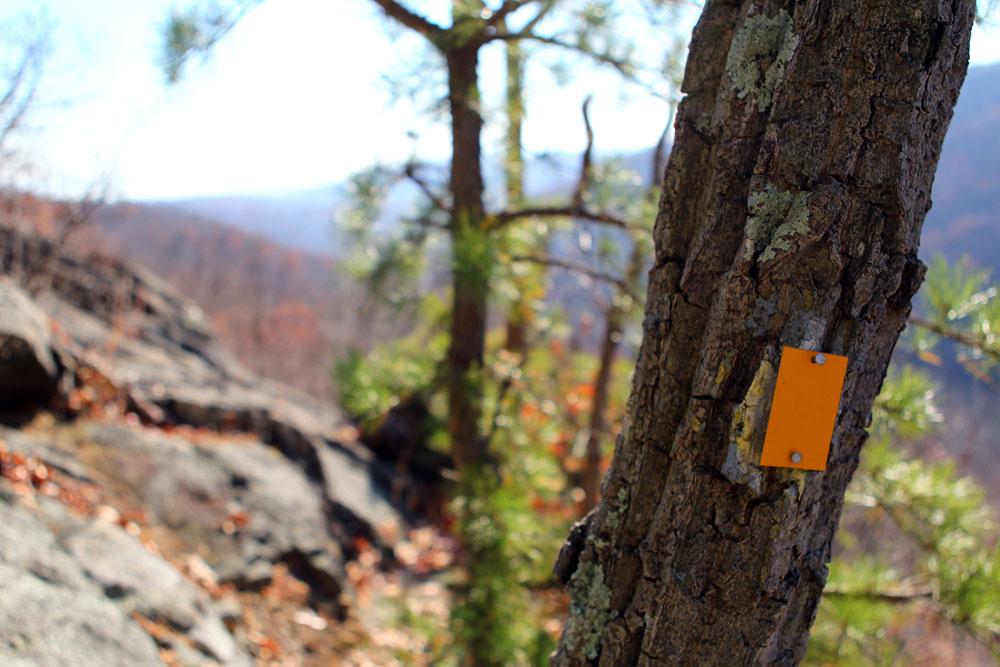
The yellow-blazed Suffern-Bear Mountain trail at the top of Pyngyp Mountain. Some of the best hiking in New York State is found only 25 miles north of New York City. And on the trails,the journey is just as enchanting as the view, the lake, the lean-to — whatever your destination. ©www.myharriman.com
Hike Some of New York State’s Best Trails
Cool, inviting lakes, gentle summits punctured with rocky balds, entrancing views, and deep, soothing wilderness are all yours on the trails of Harriman State Park, New York.
You can wind through old, abandoned mining villages and the ruins of mansions or more modest dwellings, or follow once-used roads that have reverted almost entirely to their wild state. Other trails that lead to lakes beckon a fair share of fisherman and beginning backpackers and stealth campers; some pass stone-and-chestnut lean-tos that are age-old but still inviting.
Sometimes the view are spectacular and take you by surprise (you can often see the monochrome outline of the New York City skyline from between the branches of a pinon pine); sometimes a stand of primeval cedars and hemlocks, silent in a winter snowfall, will take your breath away.
Many trails are easy to reach, and you can park your car on the road, close to the trailhead (check our map for legal locations); some trailheads are more interior and, as a reward, are also less travelled.
But always, the main, blazed trails are well-crafted, thanks to the work of the New York New Jersey Trail Conference. The journey is just as enchanting as the view, the lake, the lean-to — whatever your destination.
Hiking FAQ
Q. How long does it take to hike to the top of Bear Mountain?
A. Give yourself about an hour to get to the top, more or less depending on your fitness level. The average hiker will have no trouble getting up there in under an hour, and down in about half the time.
Q. Where can we hike to get a view?
A. Great views abound in the park. For a strenuous hike, try the Suffern-Bear Mountain trail up to the top of Pyngyp Mountain, or climb up the Popolopen Torne, at the very northern end of Bear Mountain State Park. Other trails that have great views are the Timp-Torne trail, the Ramapo-Dunderberg trail, and the trails near Hogencamp Mountain.
Our suggestion for finding fantastic views is to get the New York New Jersey Trail Conference map set for Harriman State Park, and follow the trails to the “stars”. These little black stars on the map will lead you to the best overall views in the park. Read our post about those stars.
Q. Where can we park to reach the trails?
A. It depends on what trail you want to hike. Download our map to plan your hike, or (better!) purchase the complete Harriman State Park map set from the New York New Jersey Trail Conference (see link above or to the right). You must park in a legal parking area, and the only way you’ll know it’s legal (true!) is if you find it on the map. Unless it’s a large parking lot, very few of the legal pull-out roadside parking areas have a sign stating they are legal (why this is so, we do not know).
There are legal parking spots all throughout the park. The only place to legally park on the Palisades Parkway, however, is at the Bookstore and Visitor Center on the center island, between Exits 16 and 17.
Q. Can we camp overnight on the trails?
A. Overnight camping is not permitted on the trails, except in or around the several lean-tos scattered throughout the park. These lean-tos were built in the 1920s and 30s to provide shelter along some of the longer trails that traverse Harriman, so that hikers from the city could do two or three-day hikes.
However, it’s certainly not unusual to find people camping in tents, hammocks, and even cave shelters in Harriman. This is known as “stealth” camping. It’s popular, it’s done, and if you choose to do it (though it’s against park regulations), observe the tenets of Leave No Trace: don’t do it near a trail or water body, keep the fire in a fire ring and make sure it’s cold to the touch when you leave, and clean up after yourself.
Harriman State Park does have other, legal overnight camping options. These are the cabins at Sebago Cabin Camp, or the tenting grounds at Beaver Pond Campground. If you are a large group, such as a scouting or church group, you can also reserve the camp grounds at Tiorati Plateau or Cedar Pond.
Q. Does the New York State Parks website have a comprehensive guide or page with information on Harriman State Park, including a map?
A. No.
Q. Are bicycles allowed on the trails?
A. No, except for the mountain bike area near Horn Hill and the Anthony Wayne Recreation Area. This trail is made of Beechy Bottom Road and part of the ski trails; it forms a top-heavy figure eight around Horn Hill.
However, for road biking, Harriman State Park is a sort of mecca, and in addition to the well-paved roadways that criss-cross the park (often with little traffic, especially during the weekdays), there are several older roads closed to traffic that are breaking down but are passable. (Road bikes also aren’t allowed on hiking trails).
After December 1, several of the roadways through Harriman close to traffic but are open to bikes.
See our post on an alternate way to get you and your bike to Harriman, via the train and ferry from Westchester.
Q. Are dogs allowed on the trails?
A. Yes. Not only are they allowed, but if they’re rescue/shelter dogs, they’re celebrated! :0) Park rules state that the dogs must be leashed.
Q. Will my dog be able to hike all the trails?
A. Your dog may find it impossible to hike some areas of trails which include steep sections and rock scrambles. This is a good example of why you should hike with the NYNJTC maps — they will show you areas of challenging steepness. The Popolopen Torne, the Pyngyp, and other steep ascents are no place for a four-legged hiker!
A good online resource for scouting dog-friendly hikes is Gone Hikin, a hiker’s blog. She takes her awesome rescued shepherd with her, and reports on areas that are too difficult for her dog.
Q. Will my cell phone work in Harriman?
A. Phones with Verizon service work well throughout the park. For AT&T and Sprint service, coverage is more iffy.
Q. Can I ride my horse on the trails?
A. No, horses aren’t allowed in the park.
Q. What time do the trails close?
A. They don’t. There is no gate that will close you in if you’re in the park past sunset, and overnight hikers will still be in the park after sundown. The park itself — and the trails — are open year-round.
Q. Can I get lost?
A. Yes. Even though the well-travelled trails tend to be extremely obvious and well-marked, it happens. Be especially careful later in the day, when you have less time to find your way back to the trail in daylight. If you have wandered from the trail, retrace your steps to where you can find the trail — don’t go deeper into the unknown. Also, be aware that on the rocky tops, it can be very easy to get off the trail if you aren’t watching carefully for trail markers.
Q. How did the trails get their names?
A. Many trails were named after the people who first traveled them and popularized them: Nurian, Tom Jones, Major Welch, etc. A few are named after some natural feature: Timp-Torne, Popolopen Gorge, Stony Brook, etc. Some pay homage to a historical event (1777 and 1779); some of the major trails are named after the towns they connect: Ramapo-Dunderberg, Suffern-Bear Mountain, Tuxedo-Mt. Ivy. Some are simply named after their blaze: Red Arrow, White Bar, Poached Egg.


